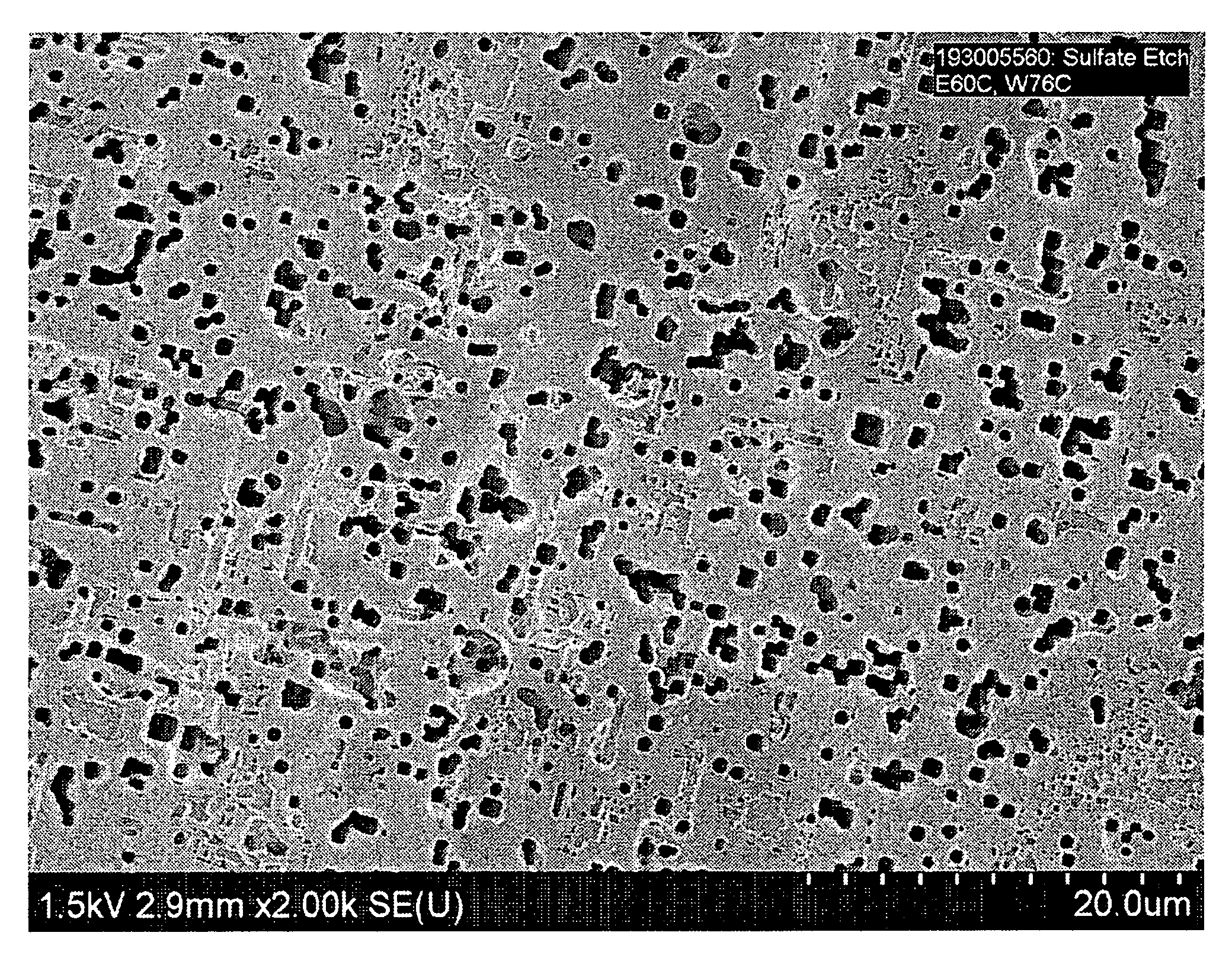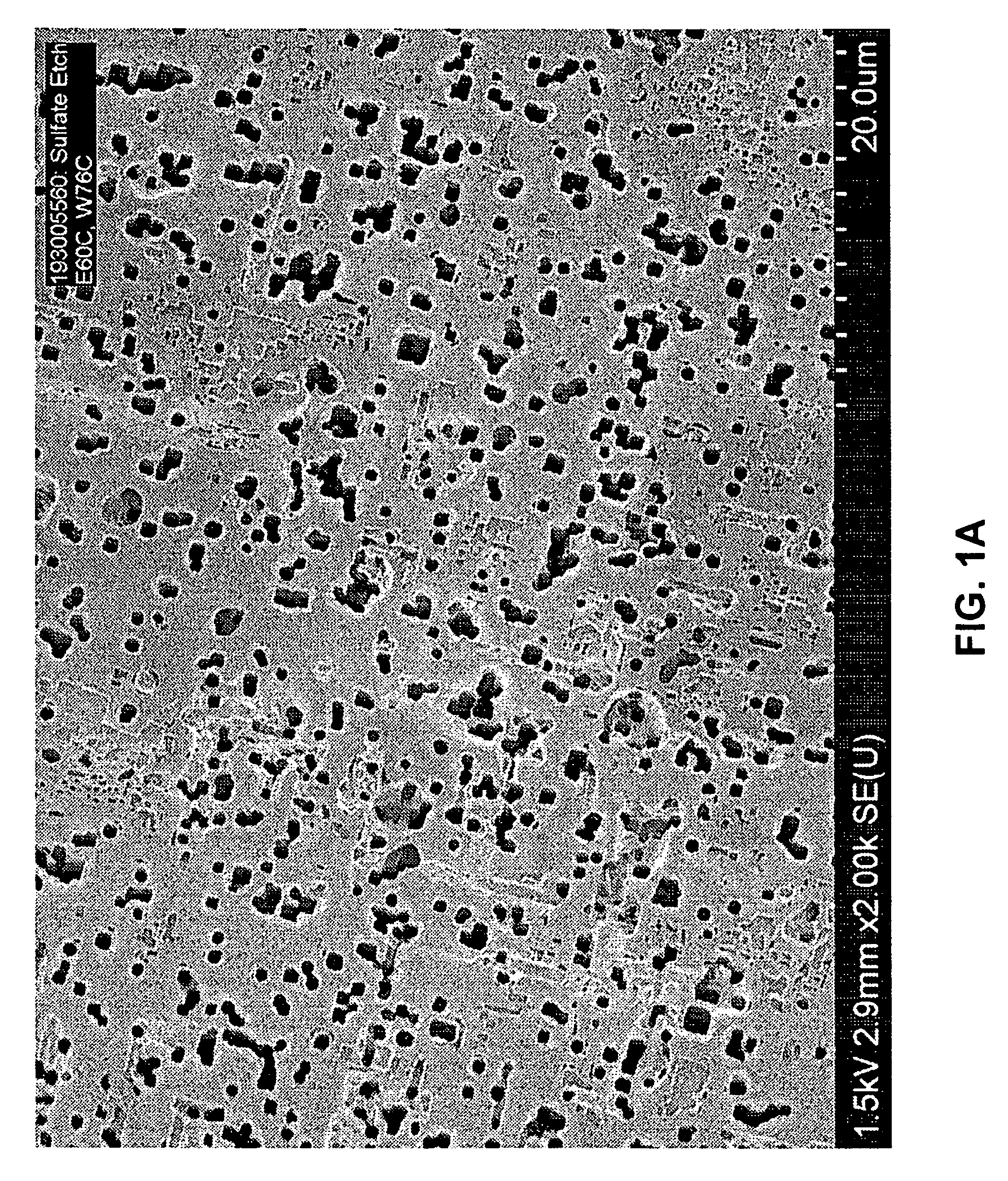Process for producing high etch gains for electrolytic capacitor manufacturing
a technology of electrolytic capacitors and etching, which is applied in the direction of manufacturing tools, electrolysis components, transportation and packaging, etc., can solve the problems of high standard deviation in foil capacitance, sodium sulfate is believed to be detrimental to foil capacitance, and sodium persulfate is thermally and electrochemically unstable, etc., to achieve high capacitance yield and easy maintenance
- Summary
- Abstract
- Description
- Claims
- Application Information
AI Technical Summary
Benefits of technology
Problems solved by technology
Method used
Image
Examples
example 1
[0043]The effect of sulfate ion concentration in an etch electrolyte solution on resulting foil capacitance was investigated.
[0044]Aluminum foil samples were precleaned in a 4 liter 0.2% HCl solution for 20 seconds. Etching was conducted in a 16 liter bath containing sulfate ion (SO42 −) as Na2SO4, NaCl, NaClO4, and glycerin. The aluminum foil samples were formed to 485 V according to a conventional formation process. In the sulfate etch experiments illustrated in Tables 1, 2, and 3, sulfate ion concentration was increased from 100 ppm to 500 ppm, with the other etch parameters kept nearly the same.
[0045]More specifically, in a first experiment, foil samples (Table 1) were precleaned in an 0.2% by weight HCl solution and etched in a solution containing 1.3% by weight NaCl, 2.6% by weight NaClO4, sulfate ion (as sodium sulfate) in a concentration varying from 100 ppm to 200 ppm, and glycerin levels varying from 10% to 19% by weight. The samples were etched at a current density of 0.1...
example 2
[0059]On an oxide covered aluminum surface, sulfate ions incorporate into the aluminum oxide layer and retard tunnel initiation. On the other hand, sulfate ions can boost tunnel initiation on fresh corrosion pits. Thus, it was investigated whether a precleaning process preceding the etch process would increase the resulting foil capacitance.
[0060]In a sulfate etch experiment, three preclean processes were compared: no preclean, 1% HCl, and 0.5% HCl solution, respectively at room temperature (˜25° C.). The precleaning was conducted in a 4 liter HCl solution for 20 seconds. The foil samples (Table 6) were etched in a 16 liter solution containing 1.3% NaCl, 2.6% NaClO4, 20% glycerol, 500 ppm SO4−2, at 0.15 A / cm2. The foil samples were then formed to 459 V according to a conventional formation process. Other etch and widening conditions, and the resulting capacitance of the foils from the experiment are shown in Table 6.
[0061]
[0062]The results indicate that precleaning increases the res...
example 3
[0064]In a neutral etch process, the chloride ion is responsible for pit initiation and tunnel propagation, and the perchlorate ion acts as an oxidizer to help create high tunnel density and long tunnels. The relative amounts of chloride and perchlorate ions were investigated to determine the effect on resulting foil capacitance with a sulfate etch process.
[0065]Two aluminum foils were etched in accordance with the methods according to Example 1 under similar parameters but different NaClO4 / NaCl ratios. The first foil was etched in an etch solution of 1.3% by weight NaCl, 3.49% by weight NaClO4, 5% by weight glycerin, and 100 ppm sulfate ion (as sodium sulfate) at an etch charge of 45 Coulombs / cm2 for 5 minutes, 2 seconds at a solution temperature of 81° C. The first foil was then widened with a charge of 87 Coulombs / cm2 for 7 minutes, 23 seconds. The first foil was etched without any precleaning.
[0066]The second foil was precleaned in an 0.5% HCl solution, then etched in an etch so...
PUM
| Property | Measurement | Unit |
|---|---|---|
| current density | aaaaa | aaaaa |
| weight ratio | aaaaa | aaaaa |
| temperature | aaaaa | aaaaa |
Abstract
Description
Claims
Application Information
 Login to View More
Login to View More - R&D
- Intellectual Property
- Life Sciences
- Materials
- Tech Scout
- Unparalleled Data Quality
- Higher Quality Content
- 60% Fewer Hallucinations
Browse by: Latest US Patents, China's latest patents, Technical Efficacy Thesaurus, Application Domain, Technology Topic, Popular Technical Reports.
© 2025 PatSnap. All rights reserved.Legal|Privacy policy|Modern Slavery Act Transparency Statement|Sitemap|About US| Contact US: help@patsnap.com



